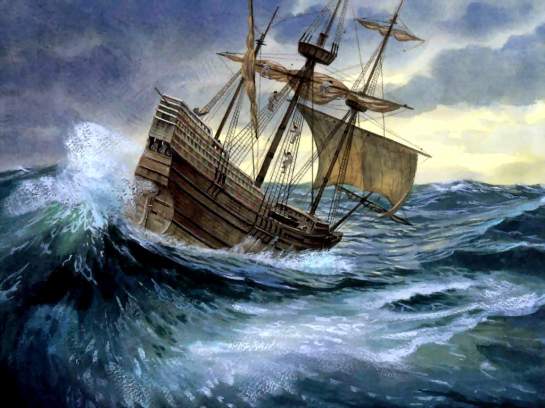Organisational Transitions
Organisational Transitions
Some time ago I wrote three posts describing each of the three transitions in the Marshall Model. Just today, I was thinking that maybe it might meet some folks’ needs to describe “organisational transitions” in slightly more general terms.
Walk and Sail, Walk and Sail
The journey from ineffectiveness to effectiveness is often a long and winding one. With many a mis-step and wrong turn along the way. Notable during this journey are its several discontinuities. By which I mean, there come times when simple, incremental changes cease to make any significant difference. At times like this, organisations on the journey find themselves on the shores of a wide ocean. Here, they may camp for a while, considering whether to build ships and set sail, or settle on the shore, never quite finding the courage to search for the new world.
“Focus on the journey, not the destination. Joy is found not in finishing an activity but in doing it.”
~ Greg Anderson
These are the times when the question of transition comes up. For the new world about which we’re talking is the new world of a different perspective. A quantum shift in mindset. A wholesale replacement of the organisation’s current memeplex with a new one. One that is wildly at variance with what has gone before.
Lewin’s Change Model
Kurt Lewin was a German-American psychologist, and one of the modern pioneers of social, organisational, and applied psychology. His work includes Lewin’s equation: B = ƒ(P, E), which states that human behaviour is a function of a person in their environment. He also developed a model of organisational and personal change, the Lewin Change Model, which describes change as a three stage process:
- Unfreezing
- Transition
- Freezing
“A change towards a higher level of group performance is frequently short-lived. After a ‘shot in the arm’, group life soon returns to the previous level. This indicates that it does not suffice to define the objective of planned change in group performance as the reaching of a different level. Permanency of the new level, or permanency for a desired period, should be included in the objective.”
~ Kurt Lewin, “Frontiers of Group Dynamics”, Human Relations, Volume 1, pp. 5-41
Bridges’ Transition Model
William Bridges created his Transition Model to describe what happens to a person internally, inside a person’s mind, as they go through change. This Model posits three stages:
- Ending, Losing, and Letting Go.
- The Neutral Zone.
- The New Beginning.
Organisations too (more specifically, the organisation’s collective mind, a.k.a. the organisational psyche) go through a similar three stages of transition – at each discontinuity. Somewhat like settlers setting sail in search of a new land:
- Casting off; setting sail; leaving one’s homeland
- All at sea
- Finding safe harbour in a new land
Stage 1: Casting Off; Setting Sail; Leaving One’s Homeland
Organisations enter this initial stage of transition when they first realise they are standing of the edge of a chasm (discontinuity). This stage is often marked with e.g. denial, anger, bargaining, depression and, maybe, ultimately acceptance that something must be done.
At this stage, people up and down the organisation may experience a range of emotions as they wonder if their needs will be met in the “new world”.
Until people realise that something is ending, they may struggle with these emotions. Acknowledging these emotions and atttending to folks’ needs can help people cope with their uncertainties.
Stage 2: All At Sea
In this stage, the organisation finds old certainties dissolving, business as usual is more or less broken, and different groups begin to pursue different agenda, often conflicting. Waste and rework will likely rise, and consequently so will workloads.
Think of this phase as the ocean between the old and the new worlds; in some ways, people will look back, fondly, towards their old homeland, while they are also trying – with excitement and trepidation, both – to find the new. And like the ocean, events can be unpredictable – by turn stormy and calm, with both fair following winds, headwinds, and doldrums.
Crossing The Open Seas
On the open seas, support is vital. Particularly mutual support. It’s likely few if any know where the new land lies, and the immensity of the sea, and being out of sight of land, can daunt even the bravest of hearts.
Stage 3: Landfall – Finding Safe Harbour In A New Land
The last transition stage is a time of homecoming, thanksgiving – and renewal. The organisation has landed in the new world. Everyone knows what to do – and there’s lots to be done!
At this stage, like Cortez, you may choose to burn your boats. The faint-hearted may wish to re-cross the ocean and return to their old world and old ways of thinking and being. And that would be a long and perilous journey indeed.
“Success is a journey, not a destination. The doing is often more important than the outcome.”
~ Arthur Ashe
Summary
Any transition is a major undertaking, Yet most organisations have no idea there is an ocean, let alone a new land. And when their steps bring them to the shore, many blithely carry on walking and get soaked – or even drown – before they even notice the ocean is there.
Is your organisation plodding along, step by painful step, through the hinterlands, or is it camped on the shore?
“If you want to build a ship, don’t drum up people to collect wood and don’t assign them tasks and work, but rather teach them to long for the endless immensity of the sea.”
~ Antoine de Saint-Exupery
– Bob


Pingback: Organisational Transitions! | taherehbarati